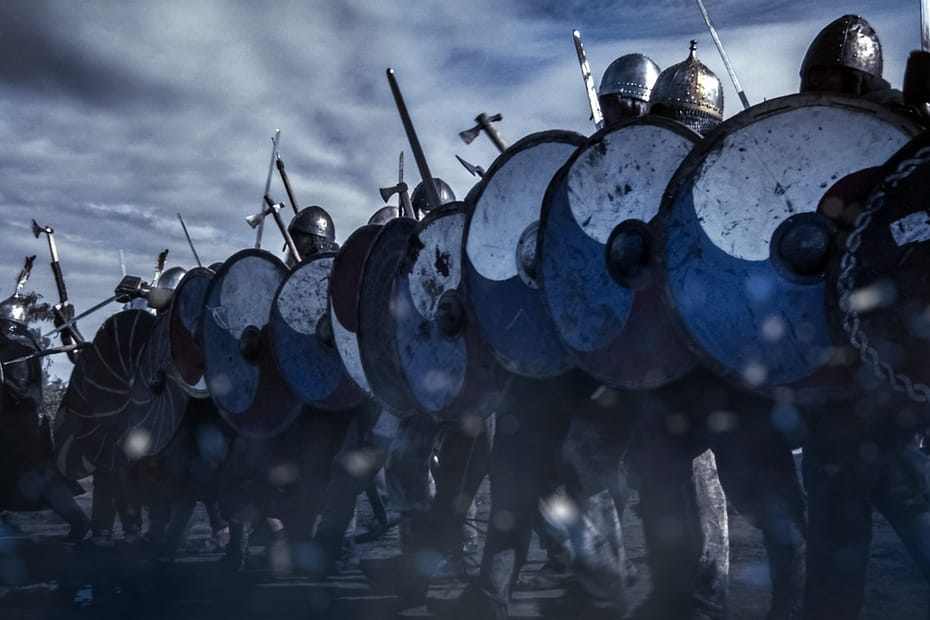There is little mention of The Battle of Wednesfield in the Anglo-Saxon Chronicles despite it marking a turning point in the wars against the Vikings. Here I try to bring together what knowledge I have about the battle.
In 909 King Edward sent a combined Mercian and West-Saxon army on a raid into the territory of the northern army. For five weeks they ravaged the area around Lincoln before returning not only with gold and slaves, but also with the bones of St Oswald (a Northumbrian king) from Bardney Abbey. These relics were relocated to St Oswald’s Abbey in Gloucester which was renamed in his honour.
… King Edward sent an army from both Wessex and Mercia, which very much harassed the northern army by their attacks on men and property of every kind. They slew many Danes and remained in the county five weeks.
The Anglo-Saxon Chronicle
In retaliation, the following summer three Danish kings, believing themselves to be safe in the knowledge that King Edward was overseeing the assembly of a fleet of 100 ships in Kent, crossed Watling Street and led an army down the Fosse Way as far as the river Avon in Gloucestershire, plundering as they went. Here they crossed the Severn and returned northwards devastating the land up into Shropshire. Wishing to return quickly with their considerable plunder to the Danelaw, they crossed the Severn again at a crossing still known as Danesford at Quatford near Bridgenorth, and started their return journey to Northumbria.
Hearing of the raids King Edward had sent troops from Wessex and Mercia to intercept the Vikings on their homeward journey, and the Vikings suffered a crushing defeat at Tettenhall west of Wolverhampton.
In this year the Angles and the Danes fought at Tootenhall on the eighth before the ides of August, and the Angles obtained the victory
The Anglo-Saxon Chronicle
Further details of the battle come for a later source written by Aethelweard, an ealdorman and member of the royal family. He writes that the battle was fought at “Uodnesfeldo Campo” – the township of Wednesfield, two miles northeast of Wolverhampton. A set of charter bounds for Bilston and Wednesfield covers the battlefield and indicates that the route back from the Severn to the Danelaw was known as “ther alde street” the old road, which is the road from Wolverhampton to Lichfield, which passes through Wednesfield where it meets a north south track.
…and following the alder-shaw to the watercourse, and following the watercourse to the road [a small stream formerly flowed near the north-eastern corner of the Wednesfield boundary and the road seems to be the present A4124 from Wolverhampton to Lichfield which passes through Wednesfield] and onwards following the old road to the hoar stone, and from the stone to the swine-fold, and from the swine-fold along the road to the dyke, along the dyke then to Kirnesford, and from the ford along the town-road to the white watercourse… [portstrete (town-road) is possibly a continuation of the Portway in Wednesbury; the boundary follows this road over Bunker's Hill. — port is a market-town]
Charter Bounds for Bilston & Wednesfield
We can conclude from this that the Danish army was on the march and found their way blocked at the crossroads by the Mercian army under the command of Aethelfaed and their West-Saxon reinforcements. If this is correct, then when the Danish army’s line was broken, they were pursued westwards with the fighting ending at Tettenhall, four miles to the west. It is possible that the royal chapel there was founded in the aftermath and is the reason the battle is named after Tettenhall and not Wednesfield.
The Winchester Chronical admits that King Edward was not there but fails to name or credit the Mercian leadership, claiming the victory for Edward rather than Aethelflaed his sister. Annals from Mercia, however, give more details of the casualties including two Kings, two Jarls, and five Holds. It even names Osferth ‘Hlytte’ a seer or omen reader among the thousands of dead.
…and there were slain king Eowils, and king Halfdan, and Ohter the earl, and Scurf the earl, and Othulf the hold, and Benesing the hold, and Anlaf the black, and Thurferth the hold, and Osferth the collector and Guthferth and Agmund the hold, and Guthferth.
The Anglo-Saxon Chronicle
This was the greatest victory since the days of Alfred the Great, and the elimination of the northern viking elite allowed his children to not just send armies across the frontier into the Danelaw to seize cattle slaves and relics but to start reclaiming territory.
